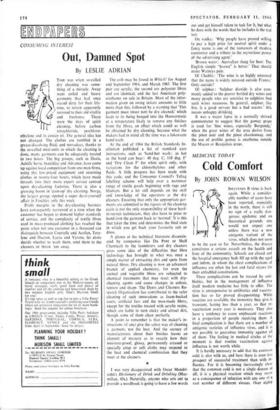EUPLAPHt
CONSUMING INTEREST
Out, Damned Spot
By LESLIE ADRIAN
TIME was when so-called dry cleaning was some- thing of a miracle. Away went soiled and heavy garments that had once stayed dirty for their life- time, to return apparently restored to their old vitality and freshness. Those were the days of spirit cleaning, before carbon tetrachloride, perchloro- ethylene and its cousin tri. The general idea has not changed. The clothes are tumbled in a grease-dissolving fluid, and nowadays, thanks to the so-called mini-units in which the cleaning is done, many garments can be adequately treated in two hours. The big groups, such as Davis, Achille Serre, Sketchley and Advance, have come up against local competition from one-man firms, using this low-priced equipment and returning clothes in twenty-four hours, which have made inroads into their more expert service centred upon dry-cleaning factories. There is also a growing boom in `coin-op' dry cleaning. Norge, the largest group, opened a super do-it-yourself affair in Finchley only this week.
Profit margins in the dry-cleaning business have consequently narrowed at a time when the customer has begun to demand higher standards of service, and the complexity of textile fibres used in mass-produced clothing has reached the point when not one customer in a thousand can distinguish between Courtelle and Acrilan, Tery- lene and Dacron, Lycra and Vyrene, let alone decide whether to wash them, send them to the cleaners or throw 'em away. The crib may be found in Which? for August and September 1964, and March 1965. The first pair are acrylic, the second are polyester fibres and are identical, and the last American poly- urethanes on sale in Britain. Most of the infor- mation given on swing tickets amounts to little more than this, followed by a warning that 'This garment must (must not) be dry cleaned,' which leads to its being bunged into the Hoovermatic at a temperature likely to remove any finishes from the fibres, an effect which could as well be obtained by dry cleaning, because what the makers had in mind all the time was a lukewarm hand-wash.
At the end of 1964 the British Standards In- stitution published a list of standard care instructions, such as 'hand-hot wash: as hot as the hand can bear: 48 deg. C, 118 deg. F' and 'Dry Clean F' for white spirit only, with variations for the chlorethylenes and other fluids. A little progress has been made with this code, and the Consumer Council's Teltag labelling scheme will help over a narrower range of textile goods beginning with rugs and blankets. But a lot still depends on the skill and knowledge of the operators at the dry cleaners. Ensuring that only the appropriate gar- ments are submitted to the rigours of the cleaning cycle is not the only responsibility of these hard- to-recruit technicians, they also have to press or hand iron the garment back to 'normal.' It is this that takes the time and determines the final state in which you get back your favourite suit or dress.
A glance at the technical literature dissemin- ated by companies like Du Pont or Shell Chemicals to the launderers and dry cleaners gives some idea of the difficulties that fibre technology has brought to what was once a simple matter of extracting dirt and spots from natural fibres. Dry cleaning is now an advanced branch of applied chemistry, for even the animal and vegetable fibres are subjected to chemical treatments that may react with dry- cleaning agents and cause changes in colour, texture and shape. The Dyers and Cleaners Re- search Organisation has contributed to the safer cleaning of such innovations as foam-backed coats, artificial furs and the man-made fibres, except for the textiles treated with acrylic resins, which are liable to turn sticky and attract dirt, though some of them clean perfectly.
A point to remember is that the maker's in- structions (if any) give the safest way of cleaning a garment, not the best. And the secrecy of manufacturers about their finishes leaves an element of mystery as to exactly how their moisture-proof, glossy, permanently creased or specially crisp or soft cloths may respond to the heat and chemical combination that they meet at the cleaners.


































 Previous page
Previous page